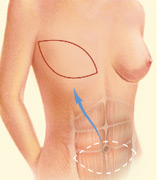Breast Cancer Part 3: Reconstruction Choices
October 28th, 2014
Take Time to Make the Right Decisions
If you are diagnosed with breast cancer, you have many choices to make. Take the time to make the right ones. Immediate reconstruction is safe, but you are not necessarily burning any bridges by delaying your reconstruction for personal reasons. No matter what your choice, breast reconstruction is inherently staged. This means it will involve multiple procedures, each being one of the stages, to achieve an optimal outcome. Breast reconstruction generally falls into two categories: implant reconstruction or reconstruction using a persons own tissue, also known as autologous reconstruction. Autologous reconstruction can be subdivided into either flap reconstruction, reconstruction with autologous fat transfer or even a combination of the two. All breast surgery will leave visible scars on the chest and although breast reconstruction will rebuild your breasts, the results are variable. Your reconstructed breast(s) will always feel different from your natural breast.
Last week we took closer look at breast reconstruction with autologous fat transfer. This week we will continue our educational series by discussing autologous reconstruction with flap techniques.
Flap Techniques
Flap techniques surgically reposition your own skin, fat and muscle to reconstruct your breast(s). Donor sites are areas of your body (abdomen, back, buttocks) where the surgeon harvests skin, fat and muscle for reconstruction. The hospital stay is usually two to five days with a recovery time of several weeks to months. These procedures offer a more natural appearance and feel than that of an implant. However, losing the muscle or part of the muscle from a donor site may leave a residual permanent weakness at that site (abdomen and/or back). You will be left with scars on your chest and another part of your body (abdomen, back or buttocks). Your reconstructed breasts will feel and look more natural but they will not be sensate.
Advances in microsurgical techniques have made free flap procedures available to patients desiring autologous reconstruction. The muscles are preserved during these procedures, therefore reducing the risks of donor site complications and permanent donor site weakness. However, these are lengthy surgeries, requiring specialized expertise in microsurgery and should only be carried out at facilities experienced with the postoperative care of free flaps. Otherwise the morbidity, complication and failure rates can be very high. Flap reconstruction procedures frequently require additional procedures to achieve the final breast contour and symmetry.
Each reconstructive technique has pros and cons. Join us for our next blog about breast reconstruction with implants. Please click here to read previous series Part 1, Part 2.
Diagram courtesy of American Society of Plastic Surgeons
Breast Cancer Part 2: Reconstruction Choices
October 22nd, 2014
Breast Reconstruction Choices
One in eight US women will be diagnosed with breast cancer. Breast cancer is the most common cancer among women in the US. Many women are distraught by the news they have breast cancer and feel this sense of urgency to make important decisions regarding their care. We advise our patients to take time to understand their options and choices. Breast reconstruction generally falls into two categories: implant reconstruction or reconstruction using a person’s own tissue, also known as autologous reconstruction. Autologous reconstruction can be subdivided into either flap reconstruction, reconstruction with autologous fat transfer or even a combination of the two. Fat transfer is perhaps the least invasive option, using your own liposuctioned fat to reconstruct the breasts.
Fat Grafting
A newer and increasingly popular alternative in autologous (your own) reconstruction is breast reconstruction with fat grafting. Fat grafting is natural, flexible and versatile. It allows the plastic surgeon to gradually sculpt and reconstruct the breast to a natural looking shape and feel. Patients can expect breasts with a more natural look and feel. Like other reconstructive techniques, fat grafting is a staged procedure with results achieved over time. Fat is harvested from the abdomen, flanks and thighs and then is injected into the breasts through small incisions. This is an outpatient procedure, with each stage carried out every 3 to 6 months. The number of stages required for completion varies on an individual basis. Recovery time from each stage is typically less than one week with minimal down time from surgery. The results are long lasting and the patient also receives the added benefit of liposuction at the donor sites. This technique may be used for correction of deformities resulting from lumpectomy, as well as for post-mastectomy reconstruction. Studies suggest that fat graft injections may improve the quality and texture of radiated skin and provides an exciting new option for breast reconstruction. Our series continues next week. Click here if you missed Part 1.

